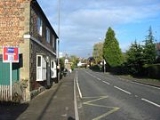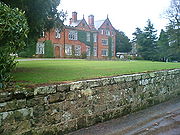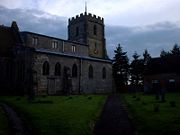
Brailsford
Encyclopedia
Brailsford is a small red brick village in Derbyshire
on the A52
midway between Derby
and Ashbourne
. The village has a pub, a post office
, a petrol station and a school. There are many fine houses in the district including two 20th century country homes: Brailsford Hall built in 1905 in Jacobean
style, and Culland Hall.


as being in the tenancy of Elfin (possibly an Anglo-norman rendering of the Saxon Aelfwine) who also held the nearby manors of Bupton, Osmaston
and Thurvaston
from the tenant-in-chief, Henry de Ferrers
.
The Domesday survey of 1086 records the following for Brailsford:
Elfin, through his son, Nicholas de Brailsford is the ancestor of the Brailsford family, who are still numerous in the county and elsewhere today.
From Pigot and Co's Commercial Directory for Derbyshire, 1835:
The parish (which has no dependent township) contained, in 1821, 724 inhabitants, & in 1831, 780.

- referring to its status as a shared church between Brailsford and the hamlet of Ednaston - is about half a mile from the village. It was originally built in the 11th and 12th centuries and consists of a nave
, chancel
, south aisle
and tower
. There have been later modifications like the 14th century chancel arch. The tower is ashlar
-faced and diagonally buttress
ed with a Perpendicular west door and west window. It contains an octagonal font in the Perpendicular style, with the lower part of the base exhibiting the Tudor rose
. In the churchyard
is a mid 11th century Saxon
cross, showing interlace and a human figure.
built 1912-14 for W.G. Player
by Sir Edwin Lutyens
, but it is not open to the public; according to Pevsner, Home Farm and Ruck o'Stones Cottage are also apparently by Lutyens. Also nearby at Muggington is the interestingly named Halter Devil Chapel, built in 1723 onto the end of a farmhouse
by Francis Brown, a reformed alcoholic, who one night attempted to halter his horse, mistakenly caught a cow, and thought it was the devil.
football match played in Ashbourne
on two afternoons during February. An annual ploughing match takes place in Brailsford on the first Wednesday in October.
Derbyshire
Derbyshire is a county in the East Midlands of England. A substantial portion of the Peak District National Park lies within Derbyshire. The northern part of Derbyshire overlaps with the Pennines, a famous chain of hills and mountains. The county contains within its boundary of approx...
on the A52
A52 road
The A52 is a major road in the East Midlands, England. It runs east from the junction with the A53 at Newcastle-under-Lyme near Stoke-on-Trent via Ashbourne, Derby, Stapleford, Nottingham, West Bridgford, Bingham, Grantham, Boston and Skegness before terminating on the east Lincolnshire coast at...
midway between Derby
Derby
Derby , is a city and unitary authority in the East Midlands region of England. It lies upon the banks of the River Derwent and is located in the south of the ceremonial county of Derbyshire. In the 2001 census, the population of the city was 233,700, whilst that of the Derby Urban Area was 229,407...
and Ashbourne
Ashbourne, Derbyshire
Ashbourne is a small market town in the Derbyshire Dales, England. It has a population of 10,302.The town advertises itself as 'The Gateway to Dovedale'.- Local customs :...
. The village has a pub, a post office
Post office
A post office is a facility forming part of a postal system for the posting, receipt, sorting, handling, transmission or delivery of mail.Post offices offer mail-related services such as post office boxes, postage and packaging supplies...
, a petrol station and a school. There are many fine houses in the district including two 20th century country homes: Brailsford Hall built in 1905 in Jacobean
Jacobean architecture
The Jacobean style is the second phase of Renaissance architecture in England, following the Elizabethan style. It is named after King James I of England, with whose reign it is associated.-Characteristics:...
style, and Culland Hall.


History
Brailsford was mentioned in the Domesday BookDomesday Book
Domesday Book , now held at The National Archives, Kew, Richmond upon Thames in South West London, is the record of the great survey of much of England and parts of Wales completed in 1086...
as being in the tenancy of Elfin (possibly an Anglo-norman rendering of the Saxon Aelfwine) who also held the nearby manors of Bupton, Osmaston
Osmaston
Osmaston may refer to:Placenames*Osmaston, Derby, England** where Osmaston Hall was*Osmaston, Derbyshire Dales** where Osmaston Manor wasPeople* Bertram Beresford Osmaston CIE...
and Thurvaston
Thurvaston
Thurvaston is a small village in South Derbyshire. In 1970 the population was put at 200. This represents a general fall since 1871 when the population was just below 400.-History:...
from the tenant-in-chief, Henry de Ferrers
Henry de Ferrers
Henry de Ferrers was a Norman soldier from a noble family who took part in the conquest of England and is believed to have fought at the Battle of Hastings of 1066 and, in consequence, was rewarded with much land in the subdued nation.His elder brother William fell in the battle. William and Henri...
.
The Domesday survey of 1086 records the following for Brailsford:
Land of Henry de Ferrers
M. In Brailsford Earl Waltheof had 2 carucates of land taxable.
Land for 2 ploughs. Now in lordship 2 ploughs.
24 villagers and 3 smallholders have 5 ploughs.
A priest and ½ church; 1 mill, 10s 8d; meadow 11 acres;
Woodland pasture 1 league long and 1 league wide.
Value before 1066, 60s; now 40s. Elfin holds it.
Elfin, through his son, Nicholas de Brailsford is the ancestor of the Brailsford family, who are still numerous in the county and elsewhere today.
From Pigot and Co's Commercial Directory for Derbyshire, 1835:
"BRAILSFORD is rather a considerable village, in the parish of its name, and hundred of Appletree; situate on the main road between Derby and Ashbourne, equidistant from each place. Coaches to different parts of the kingdom are continually passing through here, and the support of the village is chiefly derived from that circumstance - there being no manufactures, nor any extensive trade existing here. The places of worship are the parish church, and a chapel for Wesleyan methodists; the former, which is situate, about half a mile from the village, is dedicated to All Saints, and the living is a rectory, in the patronage of Earl Ferrers."
The parish (which has no dependent township) contained, in 1821, 724 inhabitants, & in 1831, 780.

Brailsford Church
Brailsford Church, or half a church as stated in the Domesday BookDomesday Book
Domesday Book , now held at The National Archives, Kew, Richmond upon Thames in South West London, is the record of the great survey of much of England and parts of Wales completed in 1086...
- referring to its status as a shared church between Brailsford and the hamlet of Ednaston - is about half a mile from the village. It was originally built in the 11th and 12th centuries and consists of a nave
Nave
In Romanesque and Gothic Christian abbey, cathedral basilica and church architecture, the nave is the central approach to the high altar, the main body of the church. "Nave" was probably suggested by the keel shape of its vaulting...
, chancel
Chancel
In church architecture, the chancel is the space around the altar in the sanctuary at the liturgical east end of a traditional Christian church building...
, south aisle
Aisle
An aisle is, in general, a space for walking with rows of seats on both sides or with rows of seats on one side and a wall on the other...
and tower
Tower
A tower is a tall structure, usually taller than it is wide, often by a significant margin. Towers are distinguished from masts by their lack of guy-wires....
. There have been later modifications like the 14th century chancel arch. The tower is ashlar
Ashlar
Ashlar is prepared stone work of any type of stone. Masonry using such stones laid in parallel courses is known as ashlar masonry, whereas masonry using irregularly shaped stones is known as rubble masonry. Ashlar blocks are rectangular cuboid blocks that are masonry sculpted to have square edges...
-faced and diagonally buttress
Buttress
A buttress is an architectural structure built against or projecting from a wall which serves to support or reinforce the wall...
ed with a Perpendicular west door and west window. It contains an octagonal font in the Perpendicular style, with the lower part of the base exhibiting the Tudor rose
Tudor rose
The Tudor Rose is the traditional floral heraldic emblem of England and takes its name and origins from the Tudor dynasty.-Origins:...
. In the churchyard
Churchyard
A churchyard is a patch of land adjoining or surrounding a church which is usually owned by the relevant church or local parish itself. In the Scots language or Northern English language this can also be known as a kirkyard or kirkyaird....
is a mid 11th century Saxon
Anglo-Saxons
Anglo-Saxon is a term used by historians to designate the Germanic tribes who invaded and settled the south and east of Great Britain beginning in the early 5th century AD, and the period from their creation of the English nation to the Norman conquest. The Anglo-Saxon Era denotes the period of...
cross, showing interlace and a human figure.
Ednaston
The hamlet of Ednaston on the other side of Brailsford Brook has Ednaston ManorEdnaston Manor
Ednaston Manor is a country house in Ednaston, near Brailsford, Derbyshire. It was built in 1912-1919 in a Queen Anne style by Edwin Lutyens, for William G. Player. It is a Grade I listed building....
built 1912-14 for W.G. Player
John Player & Sons
John Player & Sons, known simply as Player's, was a tobacco and cigarette manufacturer based in Nottingham, England. It is today a part of the Imperial Tobacco Group.-History:...
by Sir Edwin Lutyens
Edwin Lutyens
Sir Edwin Landseer Lutyens, OM, KCIE, PRA, FRIBA was a British architect who is known for imaginatively adapting traditional architectural styles to the requirements of his era...
, but it is not open to the public; according to Pevsner, Home Farm and Ruck o'Stones Cottage are also apparently by Lutyens. Also nearby at Muggington is the interestingly named Halter Devil Chapel, built in 1723 onto the end of a farmhouse
Farmhouse
Farmhouse is a general term for the main house of a farm. It is a type of building or house which serves a residential purpose in a rural or agricultural setting. Most often, the surrounding environment will be a farm. Many farm houses are shaped like a T...
by Francis Brown, a reformed alcoholic, who one night attempted to halter his horse, mistakenly caught a cow, and thought it was the devil.
Local traditions
Many locals take part in the famous Shrove TideShrove Tuesday
Shrove Tuesday is a term used in English-speaking countries, especially in Ireland, United Kingdom, Canada, Australia, New Zealand, Philippines, Germany, and parts of the United States for the day preceding Ash Wednesday, the first day of the season of fasting and prayer called Lent.The...
football match played in Ashbourne
Ashbourne, Derbyshire
Ashbourne is a small market town in the Derbyshire Dales, England. It has a population of 10,302.The town advertises itself as 'The Gateway to Dovedale'.- Local customs :...
on two afternoons during February. An annual ploughing match takes place in Brailsford on the first Wednesday in October.

